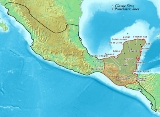
Maya civilization
Overview
Mesoamerica
Mesoamerica is a region and culture area in the Americas, extending approximately from central Mexico to Belize, Guatemala, El Salvador, Honduras, Nicaragua, and Costa Rica, within which a number of pre-Columbian societies flourished before the Spanish colonization of the Americas in the 15th and...
n civilization
Civilization
Civilization is a sometimes controversial term that has been used in several related ways. Primarily, the term has been used to refer to the material and instrumental side of human cultures that are complex in terms of technology, science, and division of labor. Such civilizations are generally...
, noted for the only known fully developed written language
Maya script
The Maya script, also known as Maya glyphs or Maya hieroglyphs, is the writing system of the pre-Columbian Maya civilization of Mesoamerica, presently the only Mesoamerican writing system that has been substantially deciphered...
of the pre-Columbian
Pre-Columbian
The pre-Columbian era incorporates all period subdivisions in the history and prehistory of the Americas before the appearance of significant European influences on the American continents, spanning the time of the original settlement in the Upper Paleolithic period to European colonization during...
Americas, as well as for its art
Maya art
Maya art, here taken to mean the visual arts, is the artistic style typical of the Maya civilization, that took shape in the course the Preclassic period , and grew greater during the Classic period Maya art, here taken to mean the visual arts, is the artistic style typical of the Maya...
, architecture
Maya architecture
A unique and spectacular style, Maya architecture spans several thousands of years. Often the most dramatic and easily recognizable as Maya are the stepped pyramids from the Terminal Pre-classic period and beyond. Being based on the general Mesoamerican architectural traditions these pyramids...
, and mathematical and astronomical systems. Initially established during the Pre-Classic period (c. 2000 BC to 250 AD), according to the Mesoamerican chronology
Mesoamerican chronology
Mesoamerican chronology divides the history of pre-Columbian Mesoamerica into several periods: the Paleo-Indian , the Archaic , the Preclassic , the Classic , and the Postclassic...
, many Maya cities
Maya city
A Maya city was a centre of population of the pre-Columbian Maya civilization of Mesoamerica. It served the specialised roles of administration, commerce, manufacturing and religion that characterised ancient cities worldwide...
reached their highest state of development during the Classic period (c. 250 to 900 AD), and continued throughout the Post-Classic period until the arrival of the Spanish
Spanish conquest of Yucatán
The Spanish conquest of Yucatán was the campaign undertaken by the Spanish conquistadores against the Late Postclassic Maya states and polities, particularly in the northern and central Yucatán Peninsula but also involving the Maya polities of the Guatemalan highlands region...
.
The Maya civilization shares many features with other Mesoamerican civilizations due to the high degree of interaction and cultural diffusion
Cultural diffusion
In cultural anthropology and cultural geography, cultural diffusion, as first conceptualized by Alfred L. Kroeber in his influential 1940 paper Stimulus Diffusion, or trans-cultural diffusion in later reformulations, is the spread of cultural items—such as ideas, styles, religions, technologies,...
that characterized the region.
Unanswered Questions

